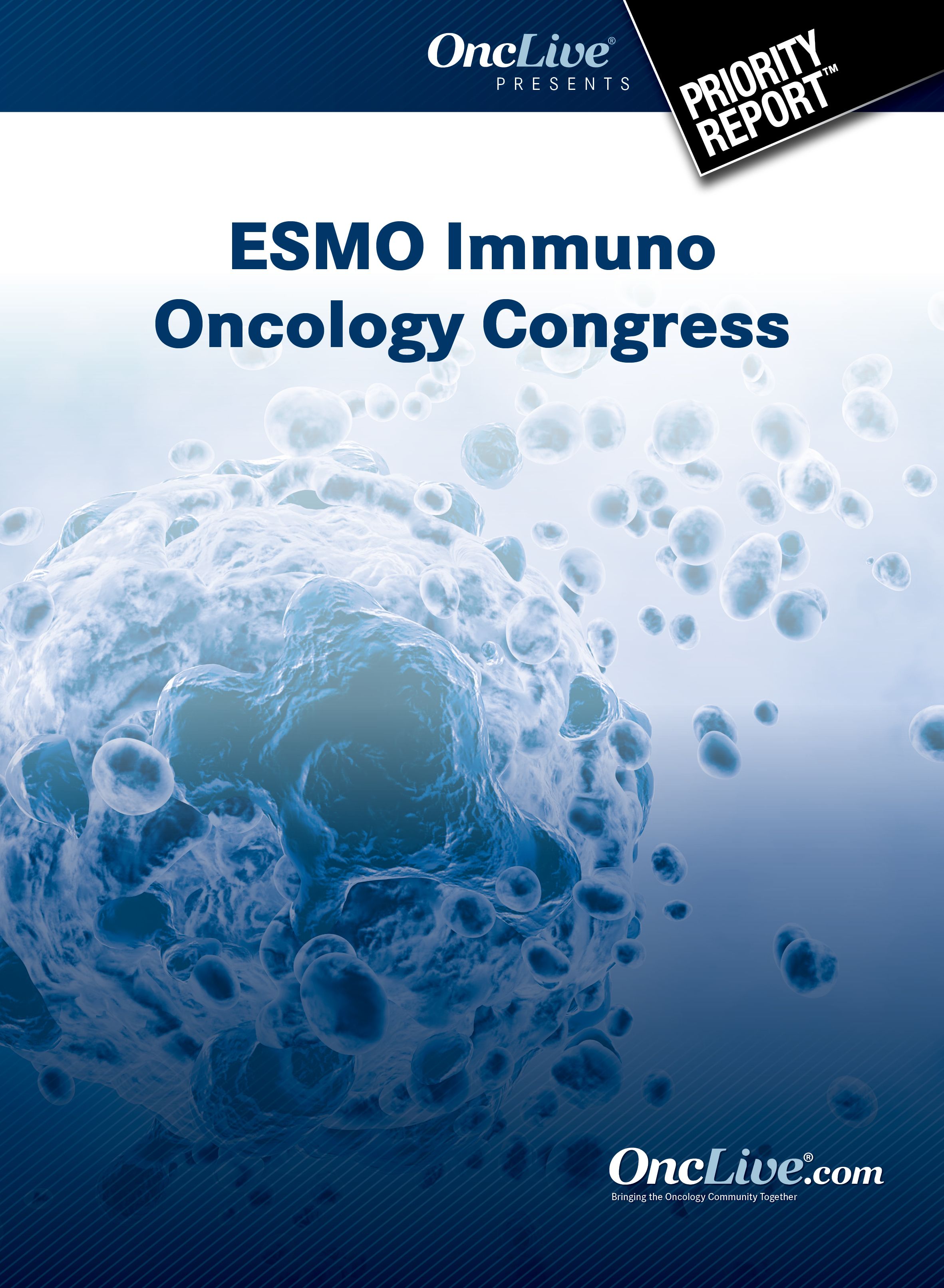Publication
Article
Safety of Frontline Durvalumab Combo Confirmed in Extensive-Stage Small Cell Lung Cancer
Author(s):
Few immune-mediated adverse events were observed with frontline durvalumab plus platinum-based therapy and etoposide in patients with extensive-stage small cell lung cancer, and no treatment-emergent antidrug antibodies were elicited by the PD-L1 inhibitor, according to an analysis of the phase III CASPIAN trial reported at the 2019 ESMO Immuno-Oncology Congress.
Mustafa Ozguroglu, MD

Mustafa Ozguroglu, MD
Few immune-mediated adverse events (imAEs) were observed with frontline durvalumab (Imfinzi) plus platinum-based therapy and etoposide in patients with extensive-stage small cell lung cancer (ES-SCLC), and no treatment-emergent antidrug antibodies were elicited by the PD-L1 inhibitor, according to an analysis of the phase III CASPIAN trial reported at the 2019 ESMO Immuno-Oncology Congress.1
The frequency of imAEs was low, but occurred more commonly with the durvalumab combination than with etoposide and platinum-based therapy alone. All-grade imAEs occurred in 20% of durvalumab-treated patients versus 3% of those on chemotherapy alone; of these, 5% versus 1% were grade ≥3, respectively.
“No patients developed treatment emergent antidrug antibodies to durvalumab and the safety profile of durvalumab plus etoposide/platinum was consistent with previous reports for both durvalumab and EP,” said Mustafa Ozguroglu, MD, professor of medical oncology, Cerrahpaşa School of Medicine, Istanbul University−Cerrahpaşa in Istanbul, Turkey. “These results support the favorable benefit-risk profile for durvalumab plus etoposide/platinum in extensive-stage small cell lung cancer.”
In CASPIAN, investigators enrolled 805 treatment-naive patients with ES-SCLC and a WHO performance status of 0 to 1, who were randomized to receive 4 cycles of etoposide/platinum plus durvalumab at 1500 mg every 3 weeks, or etoposide/platinum plus durvalumab at 1500 mg and tremelimumab at 75 mg every 3 weeks, or etoposide/platinum every 3 weeks. Investigator’s choice of carboplatin or cisplatin was allowed. Data with the tremelimumab arm has not been reported.
Following durvalumab/chemotherapy treatment, 1500 mg of durvalumab was given every 4 weeks until disease progression. Up to 6 cycles of etoposide/platinum and optional prophylactic cranial irradiation were permitted in the etoposide/platinum—alone arm.
Previously reported findings from the preplanned interim analysis of the open-label CASPIAN study showed that frontline durvalumab plus etoposide/platinum significantly improved overall survival compared with etoposide/platinum alone in patients with ES-SCLC (HR, 0.73; 95% CI, 0.59-0.91; P = .0047) at a median follow-up of 14.2 months.2
Treatment exposure with durvalumab plus etoposide/platinum was a median of 4 cycles (range, 1-6) versus 6 cycles (range, 1-6) with chemotherapy alone. Four or more treatment cycles were received by 86.8% of patients on the combination versus 84.6% of patients on chemotherapy. Most (78.5% vs 78.2%) patients on the respective treatment arms received carboplatin as the platinum agent.
Safety and pharmacokinetic results from the 265 patients who were treated with durvalumab plus EP and the 266 control patients receiving EP were presented in the safety analysis. The PK analysis showed that serum concentrations of durvalumab were within the expected range of exposure and similar across both arms.
“The PK profiles of etoposide/platinum components were similar between the durvalumab plus etoposide/platinum and etoposide/platinum—alone arms, suggesting there was no impact of durvalumab on etoposide/platinum PK when administered as combination therapy,” Ozguroglu said.
Results showed that no treatment-emergent antidrug antibodies were elicited by durvalumab. In the durvalumab plus etoposide/platinum arm, 201 (75.8%) patients were evaluated for antidrug antibodies; of these, 11 (5.5%) were positive for antidrug antibodies to durvalumab at any time. The incidence of posttreatment antidrug antibodies was 0; no patients were positive for treatment-emergent antidrug antibodies or neutralizing antibodies.
All-grade AEs occurred in 98% versus 97% of patients on durvalumab plus etoposide/platinum and etoposide/platinum alone, respectively, and grade 3/4 AEs were reported in 62% of patients on both arms. The rates of AEs leading to discontinuation were similar with both treatments (9%), although serious AEs were numerically lower at 31% versus 36%, respectively, and imAEs were higher (20% vs 3%) with the addition of durvalumab to etoposide/platinum.
The most commonly reported any grade imAEs with durvalumab/chemotherapy were hypothyroidism (9%), hyperthyroidism (5%), pneumonitis (3%), hepatic events (3%), and 2% of patients each had dermatitis/rash, diarrhea/colitis, thyroiditis, and type 1 diabetes. Grade ≥3 imAEs included pneumonitis (1%), hepatic events (2%), diarrhea/colitis (0.4%), and type 1 diabetes (2%).
The median time to onset of any grade imAEs ranged from 28 days (range, 9-114) for diarrhea/colitis to pneumonitis, with a median onset of 191 days (range, 80-365) after receiving the first dose.
With etoposide/platinum alone, the most commonly reported any-grade imAEs were hypothyroid events (1%), pneumonitis (1%), dermatitis/rash (1%), and diarrhea/colitis (0.4%). There was 1 grade ≥3 imAE, which was pneumonitis. The median time to onset of any grade imAEs ranged from 31 days (range, 27-35) for diarrhea/rash to pneumonitis, which occurred at a median of177 days (range, 141-213) following the first dose.
Thirteen (5%) patients on durvalumab/chemotherapy and 15 (6%) patients on chemotherapy alone died due to an AE; of these, 5 (2%) and 2 (1%), respectively, were determined to be related to treatment.
With durvalumab/chemotherapy, the treatment of imAEs often comprised endocrine therapy (15%) or systemic corticosteroids (9%), which resolved 44% of imAEs. Specifically, 100% of dermatitis/rash and diarrhea/colitis; 71% of pneumonitis, hepatic, and hyperthyroid events; 29% of hypothyroid events, and 25% of thyroiditis were resolved with the appropriate therapy. Type 1 diabetes cases were not resolved using these treatments.
In the etoposide/platinum—alone arm, 5 (2%) and 2 (1%) of patients received systemic corticosteroids or endocrine therapy for imAEs; of these patients, 50% of dermatitis/rash and 100% of diarrhea/colitis cases were resolved with these treatments.
References
- Özgüroğlu M, Goldman JW, Reinmuth N, et al. First-line durvalumab plus platinum-etoposide in extensive-stage (ES)-SCLC: Safety, pharmacokinetics (PK) and immunogenicity in CASPIAN. Ann Oncol. 2019;30(suppl_11):mdz453.003. doi: 10.1093/annonc/mdz453.003.
- Paz-Ares L, Dvorkin M, Chen Y, et al. Durvalumab plus platinum—etoposide versus platinum–etoposide in first-line treatment of extensive-stage non-small cell lung cancer (CASPIAN): a randomized, controlled, open-label phase 3 trial. Lancet. 2019;394(10212):1929-1939. doi: 10.1016/S0140-6736(19)32222-6.










